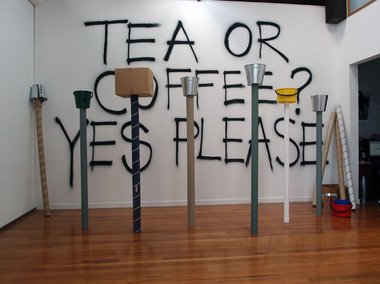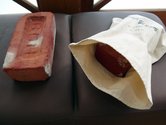Andrew Paul Wood – 2 March, 2012
A motif repeated from Hood's Masters exhibition at the University of Canterbury's School of Fine Arts last year, is the bucket precariously balanced on a pole just above head height. We wonder if there is anything in the bucket (there isn't). We wonder if it's held together in some way (it isn't). In Christchurch's still shake-prone environment, the sense of fragility and risk is palpable.
Robert Hood’s Who Laughs Last?, like most of his installations, is predicated by a sense of humour and an uncluttered simplicity of concept. Certainly Hood is rapidly developing a national profile as a Canterbury artist, and it wouldn’t be exaggerating to say that he’s one of the most interesting younger artists currently practicing in New Zealand. Christchurch born and raised, he has had numerous group and solo shows that often seem to pass under the radar, was the Olivia Spencer-Bower Artist in Residence in 2007, exhibited with the Fourth Auckland Triennial in 2009, received the Sir Robertson Stewart Scholarship in 2011 and was the only Canterbury artist represented in the Prospect survey at City Gallery, Wellington the same year.
The back wall is completely taken up with the famous Marx Brothers’ joke “Coffee or Tea? Yes please”, in bold black graffiti on the gallery-white surface. It’s an existential absurdity that can be found in much of Hood’s work and pretty much sums up the spirit of his work. The work looks deliberately half-arsed, but everywhere visual and cultural intelligence, skill and craft is evident. There is a lightness of touch despite the humble nature of most of the components of the exhibition - things seen and recreated and reconfigured, things found; Hood is a master of the objet trouvé. His lineage is part Duchamp, part Joseph Beuys, part the late Mike Kelley. Hood’s art is one of slippery and guarded conversations with his materials and readymades.
A motif repeated from Hood’s Masters exhibition at the University of Canterbury’s School of Fine Arts last year, is the bucket precariously balanced on a pole just above head height. We wonder if there is anything in the bucket (there isn’t). We wonder if it’s held together in some way (it isn’t). In Christchurch’s still shake-prone environment, the sense of fragility and risk is palpable. There is also the possibility of an anthropomorphic allusion - the pole as body, the bucket as head. Ring-o-ring-o-roses. We all fall down.
A bucket on the floor with a round hole cut into it irresistibly calls to mind the old song, “There’s a hole in the bucket, dear Liza, dear Liza, / There’s a hole in the bucket, dear Liza, a hole.” It is an example of concrete humour and a symbol of futility. Tubes on the floor suggest already fallen buckets, and perhaps (though this is largely what one might term the “Christchurch Effect”) an allusion to rubble and fallen buildings.
On the walls Hood presents a series of photo-collages of found images sourced from magazines, folded up to create anamorphic distortions. Some of the people seem to slip through another dimension, or hover in space with no legs. All have been transformed into Cyclopes - an illusion to Classical mythology - a being with one, all seeing and vulnerable eye. These beautiful and amusing works find a pop culture echo (unknown to the artist, I checked) in the website http://rosskempfolds.tumblr.com/ which makes a meme of folding up pictures of British actor and presenter Ross Kemp (Eastenders and various documentaries about gangs) to make him look as goofy as possible. Both are effective because their premise is simple and clever. There are more distant art-historical echoes of the Surrealist, Dadaist, and Punk collage.
It’s all very well put together - Hood has a knack for making his exhibitions seem like resolved organic wholes, not disparate works. I think that is probably reflective of the organic nature of his ideas and their underlying unity of interest.
Andrew Paul Wood
Recent Comments
John Hurrell
Rather than Ross Kemp, I suspect Rob has been admiring the work of the great British portrait collagist John Stezaker.(There ...







 Advertising in this column
Advertising in this column Two Rooms presents a program of residencies and projects
Two Rooms presents a program of residencies and projects



This Discussion has 1 comment.
Comment
John Hurrell, 8:37 p.m. 2 March, 2012 #
Rather than Ross Kemp, I suspect Rob has been admiring the work of the great British portrait collagist John Stezaker.(There is something about his images that makes me shudder. Most are profoundly disturbing.) I also wonder - though the possibilities are admitedly remote - if he has been thinking about Bruce Barber's 70s performance Bucket Action.
Participate
Register to Participate.
Sign in
Sign in to an existing account.